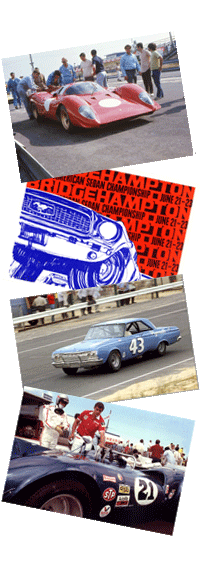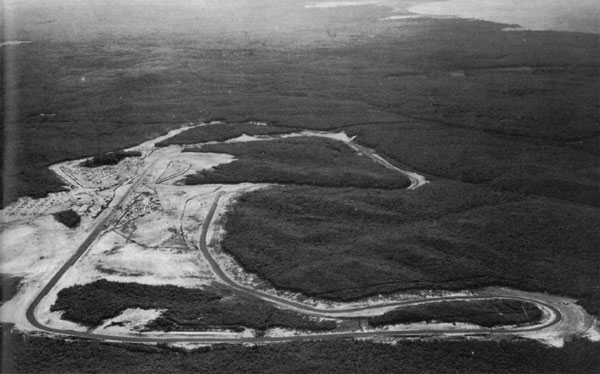
Bridgehampton: One Great Ride!

The Early Years: daredevils on country roads
New York's internationally celebrated sports car racing circuit, once described by England's World Champion Sir Stirling Moss as "the most challenging course in the States", was the product of 95 years of sports car racing on New York's Long Island.
Bridgehampton first saw action in 1915, when the annual Firemen's Fair brought a pack of very slow and smoky race cars to Montauk Highway. Decades later, a hero pilot returning from World War II with an MG TC, Bruce Stevenson of Sagaponack helped give birth to modern sports car racing all across America when he revived the Bridgehampton road racing tradition in 1949.
The post-war Bridgehampton Sports Car Races on the narrow country lanes abutting the Atlantic Ocean attracted an array of New York celebrities, the metropolitan press corps, the best America's race drivers equipped with the newest European sports cars, and hordes of spectators. During the next five years, the race entry lists grew from 58 cars to more than 180 and the spectator count increased from 10,000 to 40,000. The excitement and international flair of these competitions fit perfevtly into the sophisticated playground image that was blossoming in "The Hamptons".
"CAR HITS 3 SPECTATORS, ROAD RACE IS CANCELED"
headlined the New York Herald Tribune on May 24, 1953. With a series of spectacular accidents, the death knell was sounded for racing on the public roads of Bridgehampton. The demise of street racing was caused when a competitor swerved to avoid a spectator chasing his wayward hat across the roadway. With racing speeds exceeding 130 mph and crowds scattered over the four-mile length of the circuit, snow fences and hay-bale barriers had clearly become inadequate to contain the fast-evolving sport.
A New Idea: a purpose-built road racing circuit
 That fateful summer of 1953, a rare melding of captains of indsutry and urbane New Yorkers came together with local merchants, farmers and shade-tree mechanics to begin planning America's first purpose built road racing circuit. The Bridgehampton Road Races Corporation (BRRC) was authorized to issue stock on November 30, 1953. Its officers were local businessmen and the Board of Directors included representatives form the Motor Sports Club of America, Sports Car Club of America and Long Island Sports Car Association plus the larger-than-life proprietor of the Long Island Automotive Museum, Henry Austin Clark Jr.
That fateful summer of 1953, a rare melding of captains of indsutry and urbane New Yorkers came together with local merchants, farmers and shade-tree mechanics to begin planning America's first purpose built road racing circuit. The Bridgehampton Road Races Corporation (BRRC) was authorized to issue stock on November 30, 1953. Its officers were local businessmen and the Board of Directors included representatives form the Motor Sports Club of America, Sports Car Club of America and Long Island Sports Car Association plus the larger-than-life proprietor of the Long Island Automotive Museum, Henry Austin Clark Jr.
The directors immediately began searching for an appropriate site for the new circuit. An uninhabited hilltop on the north slope of the glacial ridge west from Sag Harbor looked promising. Known as "the backwoods", these lands were granted to local settlers by King James II as part of a Royal Charter in 1685 and were later parceled out to nearby farmers for hunting and foraging. The site of the future Bridgehampton Race Circuit still retained ancient Indian spear-points and an extensive network of Indian hunting trails.
Property tax records revealed a multitude of small lots with hundreds of owners. Title searches reaching back over many generations revealed missing deeds and heirs and inaccurate property descriptions. Undaunted, the local enthusiasts began the arduous process of acquiring this rolling terrain, ideal for a race track "second to none in the world" according to the inaugural race program.
President B.J. Corrigan's gas station on Montauk Highway and Austie Clark's auto museum became stockbroker's offices. Local businessmen and strollers were offered shares at $5 a clip from a sidewalk card table in front of the Bridgehampton Candy Kitchen, which remains a popular gathering place to this day. In the end, the BRRC was able to amass almost 600 acres of the forested ridge a few miles north of Bridgehampton at a mere $60 an acre. Two Grumman engineers, Al Piloff and Jake Bohn of Garden City, were comissioned to begin engineering drawings for the new circuit, but Ercole Colasante, an immigrant racer from Italy, fine tuned the design with his bulldozer.
It was amazing, given the rush to build the track and the ovelty of the idea that Bridgehampton turned out to be the jewel it was. The initial clearing of the woods caused a buzz of excitement from Southampton to Montauk when the radical topography of the circuit was revealed for the first time. These were small towns at the time so everyone came to participate in the excitement. As the track reached final grading, farmers and summer people alike imagined the excitement of a pack of race cars thundering past in a blur of color.
The race circuit reflected the best features of three of Europe's finest race courses: Zandvoort, slicing through the sand dunes of Holland, Spa-Francorchamps, tunneling through the Ardennes forest in Belgium, and the roller-coster excitement of England's Brands Hatch. The site layout featured a jaw-dropping 180-degree view of Long Island's North Fork, Shelter Island, Sag Harbor and the sailboats on Peconic Bay. The circuit had four vertical elevation changes totalling 130 feet and eight distinct corners, including a banked hairpin curve around a hillock at the lowest point of the course. A flat-out straightaway nearly 3/4 of a mile long suddenly disappears into a hair-raising decreasing radius downhill curve, known as Millstone Turn. More than one international star has called this steep decline, which is blind and taken flat out in most race cars, the most difficult turn in racing. Sam Posey, for one, said that sailing off the abyss in a sports racer was like "flying into an air pocket" in a plane.
By 1957, the cast of characters at BRRC had changed somewhat. Mark Richard was replaced as Secretary by Henry Tredwell Jr. and Dr. William Graf became the Treasurer when Paul Widener took on the role of construction supervisor. Albert Humblet had resigned and was replaced by attorney Edwin Krom, illustrator Robert Powell and Briggs Cunningham's team manager, Alfred Momo. They joined the original directors Austin Clark, Earle Grainger, Robert Grier, Robert Hallock and Charles Moran, Jr.
